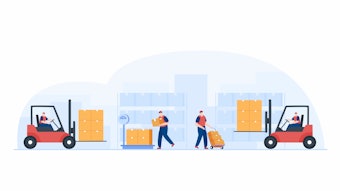
*This content is sponsored by Travero*
In the past several years, supply chain snags have become a hot button topic for many in the construction industry. However, with great challenges, come creative solutions.
These four tactics can help you take proactive steps to be better positioned to handle any challenges or disruptions during peak season and beyond.
1. Focus on the End Customer
With so many moving pieces and variables, ensuring both manufacturers and customers are positioned to make quick decisions can have a significant impact on business. That’s why, Paul Trombitas, a partner at FMI Consulting who leads the team focused on building product manufacturers, says developing a strong relationship with end users is key.
“Manufacturers should focus on the customer to really understand what their challenges are, what they need to be successful, and how, potentially, the manufacturer could assist or add value differently than they had in the past,” says Trombitas. “Establishing stronger partnerships, getting involved earlier, really understanding the needs, pain points of the end customer, is absolutely critical.”
This collaborative spirit and proactive communication can go a long way to help overcome challenges as they arise. Logistics partners like Travero see this in practice every day.
“A high level of communication equates to trust,” says Jillian Walsh, senior manager of business development for Travero, a logistics company offering full-service, customized logistics solutions, including freight brokerage, warehouse management, rail and barge terminal services. “With many companies looking at new suppliers and shipping to and from new origins now it is more important than ever to lean on others for that guidance and expertise.”
Developing a communication plan with manufacturers/suppliers and end-users to share predicted volume information, production and delivery lead times, potential stockouts and backorders is a great way to start and build up rapport, adds Walsh.
2. Understand the Geographic Landscape
Another important factor as you plan for peak season is to make sure you understand the geographic landscape in terms of where your products are going and what’s demand like in that region.
Any change of dynamics within those geographies you need to make sure, from a supply standpoint, you are prepared to address them.
“You know, there's certain parts of the country that are just booming, and then there are others that are more stagnant,” says Trombitas. “You need to think about how strong is your distribution network in those target growth geographies? How have you ensured those relationships are strong, and that you've created the partnerships to make sure your product is getting to market?”
This ties back into customer centric approach. Once you have a full picture of the landscape, you can assist in making sure their projects are moving forward, even if that means adapting to new situations.
At the end of the day, a critical piece in the construction space is the timeliness and availability of products. Keeping a finger on the pulse of what’s happening in the areas of transport sets you up to be an invaluable asset.
3. Think Outside the Box for Shipping Solutions
To respond to supply chain disruptions, Trombitas suggests taking steps to diversify your supply chain.
“What other suppliers or partners could you use to partner with to ensure that that you can mitigate against potential disruptions or challenges in the supply chain,” he says.
Looking at alternative products, suppliers or carries are just a few ways to diversify. However, this can be a daunting task to some. Having the right partner by your side can make all the difference as you navigate this new space.
“At times, companies can become complacent and do things the way they’ve been doing them for years,” says Walsh. “We strongly encourage shippers to reach out to experts, like Travero, to look at alternative logistics solutions to assist with reducing transportation costs and delivery delays.”
The experts at Travero have decades of experience shipping, transloading and warehousing during agricultural, retail and construction peak seasons. They work with customers to ensure they are utilizing the best mode of transportation, are receiving the lowest costs to move their freight and provide a team of experts for them to check in with on inventory levels and logistics needs.
This experience enables them to give their customers the tools they need for to succeed and explore new opportunities.
4. Start Thinking About the Future
Focusing on customers, having your finger on the pulse on what’s happening in specific geographic regions and diversifying are all important tactics for building resilience and improving responsiveness. However, it’s also important to start planning for the future.
“Looking further down the road, are the products that we have currently, the ones that are going to be used 5 years, 10 years down the road? And is the way we're building projects now the same way we're going to be building them in five to 10 years,” questions Trombitas.
Planning strategically will need to be a team effort. Bringing in your team, partnering with outside sources and turning to associations for education and training are all excellent ways to start building this outline and preparing for successes ahead.
Looking for more tips on how to overcome supply chain disruptions? Check out this eBook to find out how partnering with an integrated logistics service provider can help improve efficiency and give you peace of mind.


























